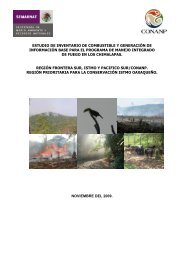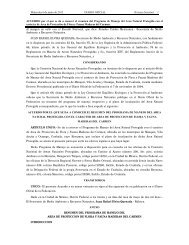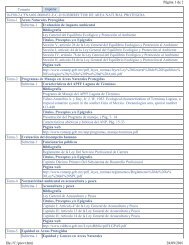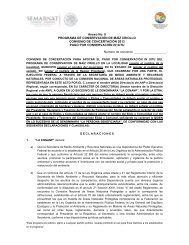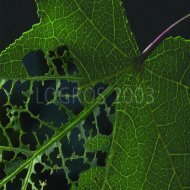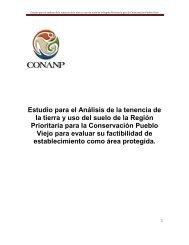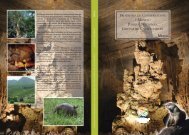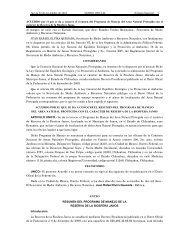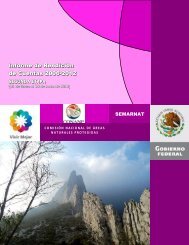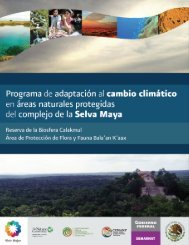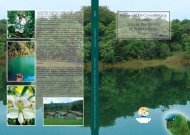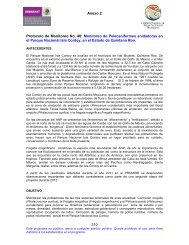Triptico FLORA.indd - Reserva de la Biosfera El Pinacate y Gran ...
Triptico FLORA.indd - Reserva de la Biosfera El Pinacate y Gran ...
Triptico FLORA.indd - Reserva de la Biosfera El Pinacate y Gran ...
You also want an ePaper? Increase the reach of your titles
YUMPU automatically turns print PDFs into web optimized ePapers that Google loves.
Fauna Representativa<br />
en <strong>la</strong> <strong>Reserva</strong> <strong>de</strong> <strong>la</strong> <strong>Biosfera</strong><br />
<strong>El</strong> <strong>Pinacate</strong><br />
y <strong>Gran</strong> Desierto <strong>de</strong> Altar<br />
Flora Representativa<br />
en <strong>la</strong> <strong>Reserva</strong> <strong>de</strong> <strong>la</strong> <strong>Biosfera</strong><br />
<strong>El</strong> <strong>Pinacate</strong><br />
y <strong>Gran</strong> Desierto <strong>de</strong> Altar<br />
<strong>El</strong> <strong>Pinacate</strong> y <strong>Gran</strong> Desierto <strong>de</strong> Altar,<br />
concentra alre<strong>de</strong>dor <strong>de</strong>l 18% <strong>de</strong> <strong>la</strong><br />
flora registrada para el estado <strong>de</strong> Sonora<br />
(553 especies), sobresaliendo <strong>la</strong><br />
Gobernadora, los imponentes Sahuaros,<br />
Chol<strong>la</strong>s y Ocotillos.<br />
De igual manera se pue<strong>de</strong>n apreciar<br />
flores multicolores como <strong>la</strong> Verbena <strong>de</strong><br />
<strong>la</strong>s Dunas color púrpura; el Ajo o Li<strong>la</strong><br />
<strong>de</strong>l Desierto, entre otras más.<br />
Estación Biológica:<br />
Carretera #8. Kilometro 51<br />
<strong>de</strong> Puerto Peñasco a Sonoyta,<br />
Puerto Peñasco, Sonora, México.<br />
Telefonos:<br />
(638) 384-9007<br />
(638) 384-9008<br />
Email:<br />
pinacate@conanp.gob.mx<br />
CONSERVA NUESTRA BIODIVERSIDAD<br />
¡<strong>El</strong> <strong>Pinacate</strong>, un <strong>de</strong>sierto con mucha vida!
La vegetación compren<strong>de</strong> principalmente<br />
matorrales xerófilos, (en climas secos y áridos)<br />
aunque en algunas áreas bien restringidas se<br />
pue<strong>de</strong> encontrar vegetación parecida al chaparral,<br />
mezquitales<br />
asociados a p<strong>la</strong>yas y<br />
matorrales arborescentes,<br />
a<strong>de</strong>más <strong>de</strong><br />
pequeñas extensiones<br />
<strong>de</strong> matorrales halófilos<br />
costeros.<br />
OCOTILLO<br />
(Fouqueria splen<strong>de</strong>ns)<br />
Presenta tallos<br />
comúnmente rectos,<br />
espinosos, sus hojas<br />
aparecen <strong>de</strong>spués <strong>de</strong><br />
<strong>la</strong> lluvia, y <strong>de</strong>saparecen<br />
<strong>de</strong> nuevo cuando<br />
el suelo se seca. Florece<br />
<strong>de</strong> Marzo a Junio,<br />
algunas veces más<br />
tar<strong>de</strong>.<br />
GOBERNADORA<br />
(Larrea tri<strong>de</strong>ntata)<br />
Arbusto <strong>de</strong> tamaño<br />
medio, que en épocas<br />
<strong>de</strong> lluvia presenta<br />
hojas y es cubierto<br />
por flores amaril<strong>la</strong>s.<br />
En períodos secos, <strong>la</strong><br />
mayoría <strong>de</strong> sus hojas<br />
caen, quedando en <strong>la</strong><br />
p<strong>la</strong>nta sólo <strong>la</strong>s hojas<br />
<strong>de</strong> sus extremos.<br />
Es una p<strong>la</strong>nta<br />
alta, con sus espinas<br />
or<strong>de</strong>nadas en columnas.<br />
Las p<strong>la</strong>ntas más<br />
antiguas tienen <strong>de</strong> 150<br />
a 200 años. Su lento<br />
crecimiento y capacidad<br />
<strong>de</strong> retener gran<strong>de</strong>s<br />
cantida<strong>de</strong>s <strong>de</strong> agua, le<br />
permiten florecer cada<br />
año.<br />
SAHUARO<br />
(Carnegiea gigantea)<br />
RAMA BLANCA<br />
(Encelia farinosa)<br />
P<strong>la</strong>nta con muchas<br />
hojas, con flores<br />
amaril<strong>la</strong>s. Los tallos<br />
liberan una resina fragante,<br />
que los Indios<br />
usaban como incienso<br />
en <strong>la</strong>s Iglesias <strong>de</strong> Baja<br />
California.<br />
PALO FIERRO<br />
(Olneya tesota)<br />
Es un árbol <strong>de</strong> tal<strong>la</strong><br />
mediana, con corteza<br />
gris y con un par <strong>de</strong><br />
espinas cortas y agudas.<br />
Su ma<strong>de</strong>ra es utilizada<br />
principalmente<br />
para e<strong>la</strong>borar figuras<br />
artesanales, carbón<br />
vegetal, y como combustible.<br />
Se caracteriza por<br />
su tallo globoso y florece<br />
<strong>de</strong> Abril a Mayo.<br />
En algunos lugares es<br />
utilizada para <strong>la</strong> e<strong>la</strong>boración<br />
<strong>de</strong> dulce por su<br />
abundante pulpa. En<br />
el <strong>de</strong>sierto sonorense<br />
esta consi<strong>de</strong>rada<br />
como especie rara.<br />
BIZNAGA<br />
(Ferocactus acantho<strong>de</strong>s)<br />
PALO VERDE<br />
(Cercidium microphyllum)<br />
Cuando florece,<br />
es cubierto por flores<br />
amaril<strong>la</strong>s. Aún cuando<br />
no presenta hojas, los<br />
árboles permanecen<br />
<strong>de</strong> color ver<strong>de</strong> en el<br />
<strong>de</strong>sierto.<br />
CHOYA GÜERA<br />
(Cylindropuntia bigelovii)<br />
Cactacea <strong>de</strong> mediana<br />
estampa (30-60<br />
cm) <strong>de</strong> color ver<strong>de</strong><br />
amarillento con espinas<br />
cubriendo <strong>la</strong> totalidad<br />
<strong>de</strong> su cuerpo. Su<br />
raiz es utilizada como<br />
medicina contra <strong>la</strong>s<br />
piedras en el riñon.



